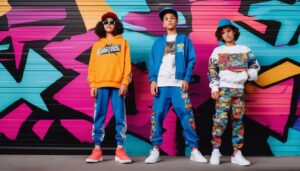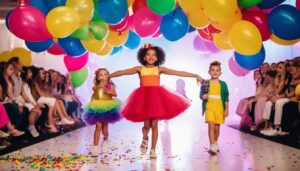Exploring Colorful Fashion Options for Children. The colors form an integral part of the development and mood of your child. When choosing adorable fashion clothes for children, more thinking than just settling on one style are important. Indeed, research has shown that bold colors and bright patterns instantly grab children’s attention and aid with the development of their cognitive skills.
The psychology of fashion color choices goes beyond looks. Red, blue, and yellow bring out playfulness and energy in children. Soft colors create a calm environment. Your child’s confidence grows when they wear colorful clothes during group activities. These bright colors also make them easy to spot in crowds. This complete guide will show you how to use color theory in children’s fashion to build a wardrobe that helps your child’s emotional growth and development.
Understanding Age-Appropriate Color Choices:
Research shows how children’s color choices change a lot as they grow up. Young children are drawn to bright, vivid colors that help develop their visual senses.
Color Preferences by Age Group:
Your child’s color choices naturally move with age. Studies show that babies see only black and white at first. They learn to notice red first, and then other primary colors come next. Toddlers soon show clear favorites, with blue becoming a popular choice whatever their gender. All the same, kids aged 3-5 love vibrant colors, while older children develop more subtle priorities.

Developmental Considerations in Color Selection:
Parents should think over their child’s stage of development when picking adorable fashion clothes. Too many colors can overwhelm a young child’s attention span. So, finding the right mix of exciting and calm colors helps support brain development.
To name just one example, bright colors like yellow and orange boost creative play, while cooler shades like blue and green help kids focus during learning. On top of that, early color experiences can shape what colors we like later in life.
Building Confidence Through Age-Appropriate Fashion:
The bright colors in children’s clothes help promote self-confidence. The Journal of Applied Psychology found that kids wearing bright, colorful outfits showed more confidence and excitement in group activities.
A Versatile wardrobe Must Include:
- Primary Colors: Red, Yellow, Blue helps to set the tone and make everything enjoyable.
- Calming Tones: Pinks and muted colors aid in concentration.
- Personal Choices: Colors that resonate with your child’s preferences.

Kids learn decision-making and self-esteem when they select their own colors. Studies indicate that children who are happy with their clothing choices tend to socialize more and interact with their peers positively.
Making a Versatile Color Wardrobe:
The first step to develop a versatile wardrobe is to put together selected pieces in the right colors for your child.
A well-laid-out color palette will give you the ability to mix and match cute fashion clothes every day.
Essential Color Combinations for Everyday Wear:
Neutral colors create a solid foundation for your child’s wardrobe. Solid-colored bottoms in gray, black, or denim work as versatile base pieces that go together with tops of all types. It is necessary to limit the colors to three for visual balance.
In summation, a balanced wardrobe has these features:
- Neutral bases: Every outfit should contain white, black, grey, and denim.
- Common colors: A shared color scheme exists among the pieces.
- Attention Center: Certain elements are well highlighted because they are enhanced with jewelry.
Combination of Garments with Monochromatic Colors:
Exploring Colorful Fashion Options for Children. The crux of proper matching lies in the inclusion of combinations that have a common color or theme. Stripes, polka shapes, and little flowers are considered simple, and they are the easiest to combine as long as there is one color in common.
You should pair one patterned item with solid colors to create balanced outfits instead of combining multiple complex patterns. A child is able to stick to this rule. One color and one pattern per outfit, or two solid colors together. This makes it easy for children to put clothes together themselves and encourages them to choose outfits independently.

Seasonal Color Transitions in Children’s Fashion:
Changes need thoughtful color adjustments in your child’s wardrobe. Spring brings light colors, with soft pink t-shirts that look excellent with white leggings. Summer is perfect for bright T-shirts paired with jean shorts or skirts.
Earth tones take center stage in autumn, with mustard yellows, browns, and greens leading the palette. Winter fashion features deeper blues with bright yellows or stark whites combined with rich reds for eye-catching contrasts.
Each piece’s versatility matters more than strict seasonal rules. Summer tops can work well with cardigans for fall, and dresses pair nicely with leggings when temperatures drop. This method allows for the utmost utilization of every article of clothing, ensuring that the overall look remains the same all year round.
Fashion Color Guide Based on Different Events:
The correct shades for various events are essential for children, not only to appear stylish but also to feel relaxed in their environment. All kids need to do is wear their cute, fashionable pieces of clothing alongside certain activities, and it will help enhance their experience and productivity.
School and Playtime Color Selections:
We picked school attire colors that support focus and learning. Neutral shades and calming blues work best in classroom settings because these colors help kids stay focused. Bright and energetic colors like yellow boost intelligence and keep children’s spirits high during playtime.

To name just one example, see these everyday school wear options:
- Neutral Base Colors: Gray, white, or brown to mix and match easily.
- Calming Blues: To improve emotional balance and focus.
- Subtle Patterns: To look neat while showing personality.
Special Event Color Coordination:
Special occasions call for thoughtful color choices that match the event’s importance. Classic colors like black, white, or gold create an elegant look at formal gatherings. Birthday parties and celebrations look best with bright colors that capture the fun spirit.
Holiday gatherings and formal events work well with:
- Gold or Metallic Accents: Great for festive times
- Classic White: Perfect for formal events
- Rich Purple: Adds celebration vibes.
- Deep Red: Balances formal and festive looks
Sports And Outdoor Activity Color Choices:
Exploring Colorful Fashion Options for Children. Outdoor activities need practical colors that go beyond looks. Dark colors hide stains better, which makes them ideal for long trips or outdoor play. On top of that, warm colors linked to the sun and heat create an energetic mood that’s perfect for sports.
Bright colors help parents keep track of their kids during outdoor activities and give them an energy boost. Warm tones like orange and yellow naturally fit active play and encourage a fun, stimulating environment.
Note that comfort should come before style when picking colors for activewear. Choose breathable fabrics in colors that won’t show dirt or grass stains. This practical approach allows children to concentrate on their pursuits while disregarding any concerns about their appearance.
Practical Color Theory in Children’s Outfits:
Understanding color theory changes everything when it comes to children’s fashion. The art of colors helps in developing unique styles that will definitely boost your child’s personality.

Basic Ideas of Color Wheel for Parents:
A color wheel is like a map that can help you coordinate clothes, and it is organized into three major subdivisions, which are primary colors of red, yellow, and blue; secondary colors of green, orange, and purple; and finally tertiary colors, which can be combinations like yellow-orange and blue green. These colors serve as the foundation for all fashion choices.
Complementary Colors:
Sets of varieties that are on inverse sides on the variety wheel are called integral tones, and when assembled, they make staggering impacts.
Examples of classic complementary pairs include:
- Red with green.
- Yellow with purple.
- Blue with orange.
When one color dominates and the other is used for highlights, these combinations look the most vivid. This strategy prevents outfits from looking too busy or overwhelming.
Creating Balanced Outfits with Color:
A yellow, yellow-orange, and orange mix makes a firm outfit that grabs the attention. The 60-30-10 rule will give an ideal visual equilibrium: 60% prevailing variety, 30% optional variety, and 10% complement tone. Patterns and prints look their best when they include colors from the same family or complementary pairs.

Exploring Colorful Fashion Options for Children. Simple clothes are a wonderful starting point for casual everyday outfit combinations. You can also include colored pieces that match or go well with items already in the wardrobe based on color theory principles. It makes integration easier while helping children learn about colors and their relationships in practical scenarios.
You should remember that triadic colors (three colors equally spaced on the wheel) make bright and fun mixes that are very pleasing to children. Balance is key when having multiple colors and so is allowing one color to dominate so that the final result does not clash.
Smart Shopping Tips for Colorful Fashion:
Smart choices about adorable fashion clothes for children start with balancing quality and cost. An overwhelming 85% of used clothing ends up in landfills. This makes buying decisions vital for your wallet and the environment.
Quality Considerations for Vibrant Clothing:
We focused on fabric selection when shopping for colorful children’s wear. Soft, stretchy cotton is ideal for young children’s comfort and movement. Natural fabrics give superior breathability and are gentle on sensitive skin. They’re worth the investment for everyday wear.
Active children need durable clothes. You should look for reinforced stitching and double-layered knees in pants that stand up to regular wear. Quality indicators include:
- Fabric Feel: Soft, breathable materials that don’t irritate skin.
- Construction: Well-made seams and sturdy buttons.
- Fit Flexibility: Room for growth without compromising comfort.
Cost-Effective Color Coordination:
Exploring Colorful Fashion Options for Children. Set price limits for different clothing categories. Most parents keep individual items under $10, except for special occasion pieces. Your budget goes further with these strategies:
Sales from preferred shops offer discounts of 20% to 50% off retail prices. Sticking to one or two reliable brands gives consistent sizing and color coordination. This is a more cost-effective method for putting together more coordinated clothing combinations.
Purchasing from a single brand ensures uniform measurements and color palettes that blend effortlessly. Some popular budget-friendly choices are:
- Zara ‘s basics and casual clothes.
- H&M on staple pieces.
- Target’s Cat & Jack range for low-income budgets.
Caring For Colored Kids Clothes:
Right upkeep supports the shade of the children wear. Sort clothing by variety and keep whites, lights, and darks separate to keep up with variety brightness. Safeguard enriching components and forestall variety blurring by turning articles of clothing back to front prior to washing.
These steps help maintain quality:
- Use cold water for washing to prevent color bleeding.
- Select a gentle, child-friendly detergent.
- Air dry, when possible, to preserve fabric quality.
Deal with stains right away to prevent permanent damage. Hot water sets protein-based stains permanently, so avoid it. Keep clothing in clean, dry areas away from direct sunlight to maintain color vibrancy.
Hang up padded hangers for fragile clothing to avoid creases and fold knitwear to keep their stitches intact. Protecting special clothes from dust and climatic changes is easy with breathable garment bags.
Conclusion:
Exploring Colorful Fashion Options for Children. To enhance the child’s character growth, his/her clothing has to be selected properly by using colors that stimulate him/her. Gaining insight into color applications and your child’s disposition and age enables you to make the right choices that make for a wardrobe that helps his or her development. Besides, the outfits should be appropriate for regular wear.
With the basic understanding of the theory of color coordination, it is much easier. It can be modified with seasonal differences, special activities, and ordinary tasks. Allowing the child to express himself or herself in a multi-purpose wardrobe should not be governed by strict rules. It should be functional.
Smart shopping and proper care of garments make your investment last longer and keep colors bright. Let your child take part in picking colors. This simple step builds their decision-making abilities and personal style confidence that stays with them beyond childhood.
A child’s wardrobe turns into a powerful tool to express themselves when you balance color psychology with practical needs. Each clothing choice matters. Think about both the immediate effects and future advantages of your color picks.
FAQs:
How do color preferences change as children grow?
As a child develops, their color preferences also change. Babies first perceive black and white, then red, and even other primary colors. When children are toddlers, they are often attracted to brighter shades, while older children develop more sophisticated preferences. Regardless of age, blue seems to be a favorite color for most people.
What are some must-have color pairings in a child’s casual outfit?
A minimalist children’s wardrobe ought to have a white, black, gray, and denim base from which other colors can be built around. These ones will serve as the foundation for other pieces. To make clothing visually appealing, limit the use of colors to three. The addition of one patterned item combined with solid colors creates a balanced style.
What role does color theory play in the choice of clothing for children by the parents?
For all parents, I use the 60-30-10 rule, which suggests that 60% has to be the dominant color of the outfit, then 30% secondary, and 10% as the accent color. This is the best approach when beginning with base pieces that are neutral, then adding the colored non-neutral pieces so that they complement or are in harmony with the base. This approach makes it simpler to dress youngsters in facilitated outfits while simultaneously showing them how to mix and function with colors.
What are some shrewd shopping methods for purchasing vivid youngsters’ clothing?
Focus on quality fabrics like soft, stretchy cotton for comfort. Look for reinforced stitching in activewear. Wait for seasonal sales to get discounts of 20% to 50%. Consider buying from a single brand for consistent sizing and color coordination. Set price limits for different clothing categories, typically keeping individual items under $10 except for special occasions.
How can parents maintain the vibrancy of colored children’s garments?
To save variety energy, sort clothing by variety and wash in chilly water. Turn pieces of clothing back to front prior to washing and utilize a delicate, kid well-disposed cleanser. Air dry, when possible, to maintain fabric quality. Tackle stains promptly and store clothing in clean, dry areas away from direct sunlight. Use padded hangers for delicate items and fold knitwear to maintain shape.


